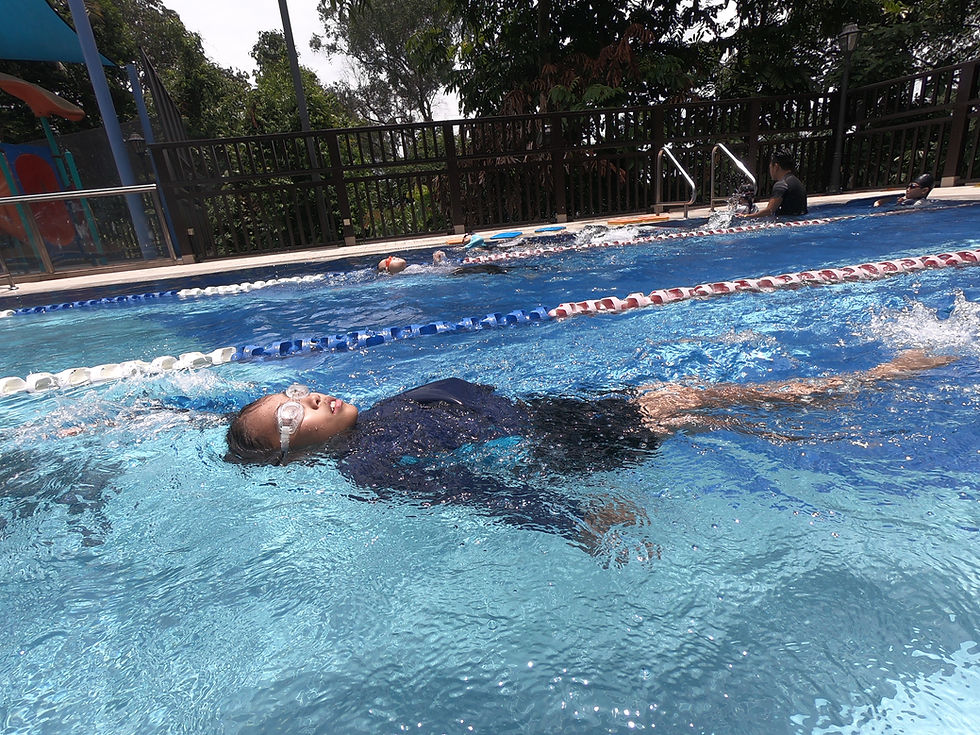The Importance of a Steady Kick in Backstroke Swimming
- SG Sink Or Swim

- Aug 19
- 3 min read

Backstroke is often considered one of the most graceful swimming strokes, characterized by smooth arm movements and rhythmic breathing. However, behind that elegance lies a powerful foundation: the kick. A steady kick is not just about propulsion — it plays a crucial role in maintaining body position, rhythm, and efficiency in the water. Whether you are a beginner or a competitive swimmer, understanding and developing a consistent backstroke kick can significantly improve your performance.
🌊 Why the Kick Matters in Backstroke
1. Maintains Body Alignment
One of the biggest challenges in backstroke is keeping a streamlined, horizontal body position. A steady flutter kick prevents the hips and legs from sinking, reducing drag and helping swimmers stay balanced on the water’s surface.
2. Supports Arm Movements
Backstroke arm strokes generate most of the propulsion, but without a steady kick, the body wobbles from side to side. A continuous, controlled kick stabilizes the body, ensuring smoother arm recovery and a more efficient stroke.
3. Boosts Propulsion
While the kick in backstroke contributes less propulsion than freestyle, it still accounts for up to 20–30% of forward motion. A strong and steady kick is especially vital in sprints, where every fraction of a second matters.
4. Improves Rhythm and Breathing
The backstroke kick sets the pace for the stroke cycle. When executed consistently, it allows swimmers to find a natural rhythm, which in turn supports relaxed breathing and endurance.
🏊 Common Mistakes with Backstroke Kicking
Kicking from the knees: This creates excess drag and quickly tires the legs. Kicking should originate from the hips with a slight knee bend.
Overly splashy kicks: While some splash is normal, too much indicates wasted energy and poor efficiency.
Uneven or inconsistent kicking tempo: Inconsistency disrupts rhythm and makes arm movements harder to control.
Dropping hips and legs: Often caused by weak or infrequent kicks, leading to a sinking position and more resistance.
🔑 How to Develop a Steady Kick in Backstroke
1. Kick Sets with a Board
Use a kickboard placed on the chest or stomach while floating on your back. Focus on small, rapid kicks driven from the hips, keeping the legs close to the surface.
2. Vertical Kicking Drills
Practice flutter kicks in a vertical position in the deep end, keeping your arms crossed or streamlined above your head. This strengthens the core and legs while enforcing steady kicking rhythm.
3. Streamline Kick on the Back
Push off the wall in a streamline position and kick without using your arms. This isolates the legs and builds endurance for steady kicking patterns.
4. Tempo Kicking with a Finis Tempo Trainer
Set a beeping timer to regulate your kick rate. This helps maintain a consistent tempo, especially useful for competitive swimmers.
5. Use Fins Wisely
Training with fins can help swimmers feel proper propulsion and body position, but should be alternated with no-fin sets to ensure natural kick strength is developed.
⚡ Takeaway
In backstroke, a steady kick is far more than just leg movement — it is the foundation of efficiency, rhythm, and speed. By focusing on proper technique and incorporating specialized drills, swimmers can improve body alignment, stabilize their stroke, and maximize propulsion. Whether your goal is smooth recreational swimming or shaving seconds off your race time, mastering a consistent kick will elevate your backstroke performance.





Comments